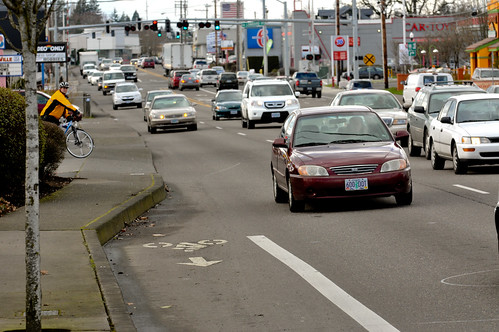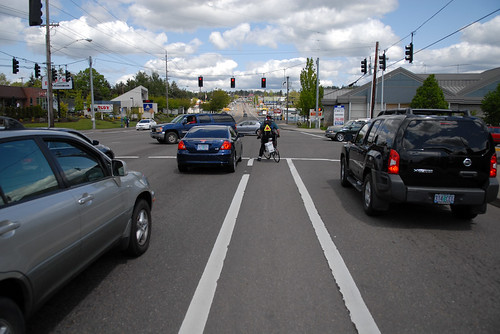(Photos: J. Maus/BikePortland)
Ms. Fast is BikePortland’s Washington County correspondent.
Sometimes I wonder if a well-intentioned “bike safety” presentation can do more harm than good.
At May’s meeting of the Beaverton Bicycle Advisory Committee (BAC), Ben Howard, committee rep and a member of the Beaverton Police Bicycle Patrol unit, gave the committee a flawlessly organized but somewhat chilling presentation on bicycle safety. He introduced it as the same presentation he and police partners regularly give at community events and at companies like Nike, providing audiences with:
— Top five bike safety tips (my paraphrase, in no particular order, is: helmet, defensive riding, defensive riding, helmet, helmet)
— Summary of commonly asked bike law questions
— A warning about being “dead right”
Not included as program bullet points were safety concerns like:
— What is being done by the city to halt traffic violations by drivers?
— To whom—exactly—riders should report unsafe bike lane obstructions?
I’ve been biking since 2005, but if my first introduction to bike commuting had come through a safety presentation like this, well-intentioned as it may be, I doubt I’d have started riding.
In my twelve years of city and suburban bike commuting, the BAC presentation marked the first time I’ve ever been to one of these bike safety presentations.
It was useful in some ways: One bit of statute-related information I became aware of is that the police can cite people for riding on a sidewalk if a bike lane is present. That describes many Washington County roads where drivers are allowed to travel at speeds of more than 50 mph — mere inches from bike lanes. I also learned there’s a fairly widespread problem with people backing their SUVs from driveways into people or other cars. The safety tip offered: “Don’t be dead right; it’s your job as the bicyclist to assume a driver won’t look to see you coming.” OK.
The safety presentation came as the BAC plans its Bike Beaverton ride, an annual event in September on Beaverton-owned streets. County-owned roads like Murray, where just last April a woman hit a person on a bike, then drove into a McMenamins, are not included as part of the ride route. Nonetheless, bicycle helmets are required for adults as well as children, unlike at Portland’s Sunday Parkways or the open streets walk and roll in Gresham this Father’s Day.
Advertisement
The BAC is adamant about the helmet requirement for adults in part because, in one member’s words, we need to “model” their use for children. In the four BAC meetings I’ve attended this year, no member has offered a rhetorical rebuttal to the adult helmet requirement. Likewise, the phenomenon of active commuter “victim blaming,” that some area cities still engage in, was not addressed during the bicycle safety presentation. (Note: Oregon state law does not require people 16 and older to wear a bicycle helmet.)
I’ve been biking on Portland, Beaverton, and Hillsboro city streets since 2005, but if my first introduction to bike commuting had come through a safety presentation like this, well-intentioned as it may be, I doubt I’d have started riding. If I was an employee who always drove to work, but was curious about cycling and happened to stop by this presentation at lunch one day, I think I’d be pretty turned off. I think I’d feel like the risks wouldn’t be worth the rewards of my effort. The reiteration that “cars” “don’t look” suggests people’s safety isn’t attended to by users or keepers of our streets. The implication that safety’s all “on me” if I want to ditch my car and walk the half mile to the county bus stop or ride a bike is pretty off-putting. I think humans are sort of hard-wired to seek out the protected part of the group, and then to stay in it.
Lucky for me I guess, I started riding a bike before I found out I wouldn’t be in society’s protected class anymore.
I want people to have and know about safety tools, but growing the number of people who believe they can set out to confidently cycle in their community should be the top safety presentation goal. Otherwise, hosts and presenters of safety classes are also in danger of being “Dead Right.” They can be so effective at fearmongering that their audience won’t even start riding bikes. And that’s too bad, because one of the most effective safety strategies a city can implement for its active commuters is the “Safety in Numbers” rule.
City leaders and officials: We need you to understand that “riding with a buddy after dark” isn’t always a work commute reality. Instead, do what it takes to help many more of us feel comfortable getting out of cars and onto bikes. In safety presentations, give riders reassurance that the city and county are working together to protect vulnerable road users by 1.) having zero tolerance for distracted, reckless drivers, and 2.) adding, maintaining, or removing, infrastructure for us in all reaches of the city. That allows real safety in big numbers, a concept that should be inherent in bike safety presentations.
Love and friendship are what happened to lead me to biking, and it never occurred to me to take a safety course. But everyone comes to bike commuting differently.
Have you ever attended a bicycle safety presentation at your company that scared you so silly you decided not to try bike commuting to work after all? On the flip side: have you been to such a presentation and it worked to help you to get out there and bike? The more, the merrier, as the saying goes! But also, the more, the safer.
UPDATE, 9:30 am on 5/22: Portland attorney Ray Thomas, author of Pedal Power: A Legal Guide for Oregon Bicyclists, commented below, providing clarification on ORS 814.420, which was referenced in the article. Thank you, Ray.
Ray Thomas presents his next free Rules of the Road Clinic at The Street Trust this July. View his March 2017 ODOT Pedestrian Safety Operations Training here, and his Bicyclist Rights in Oregon videos here.
— Naomi Fast, @_The_Clearing on Twitter
BikePortland is supported by the community (that means you!). Please become a subscriber or make a donation today.




